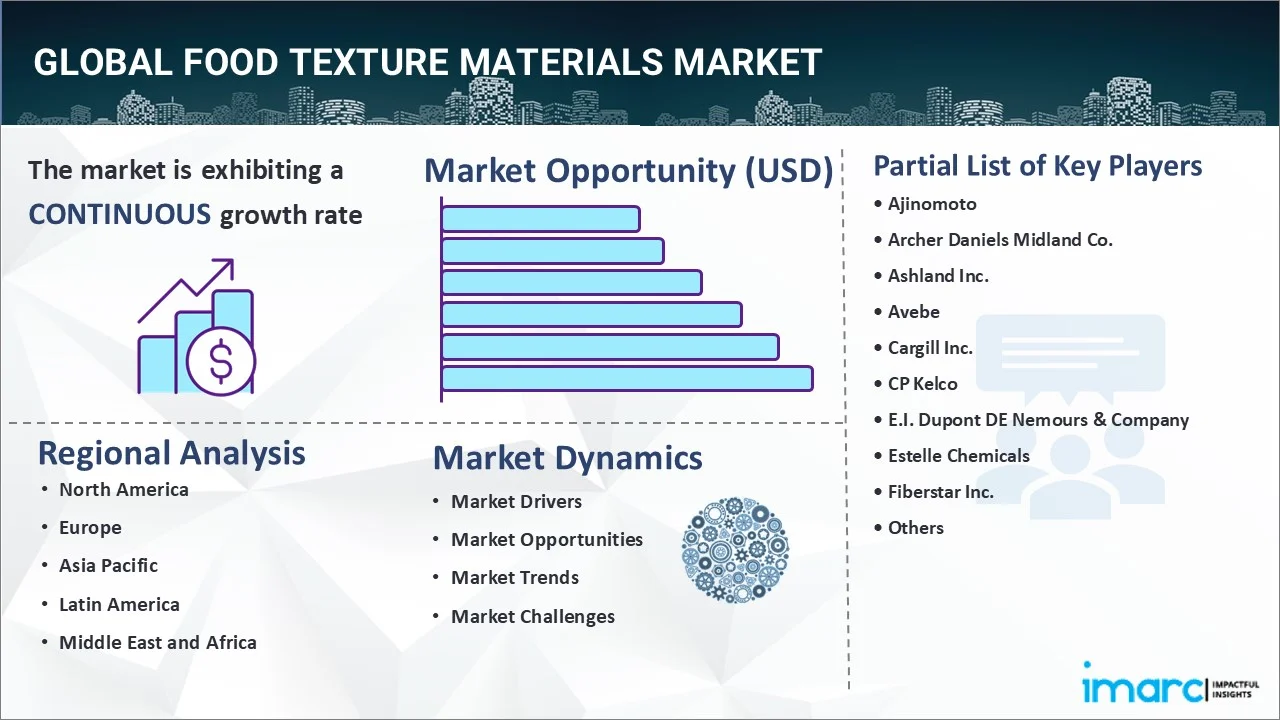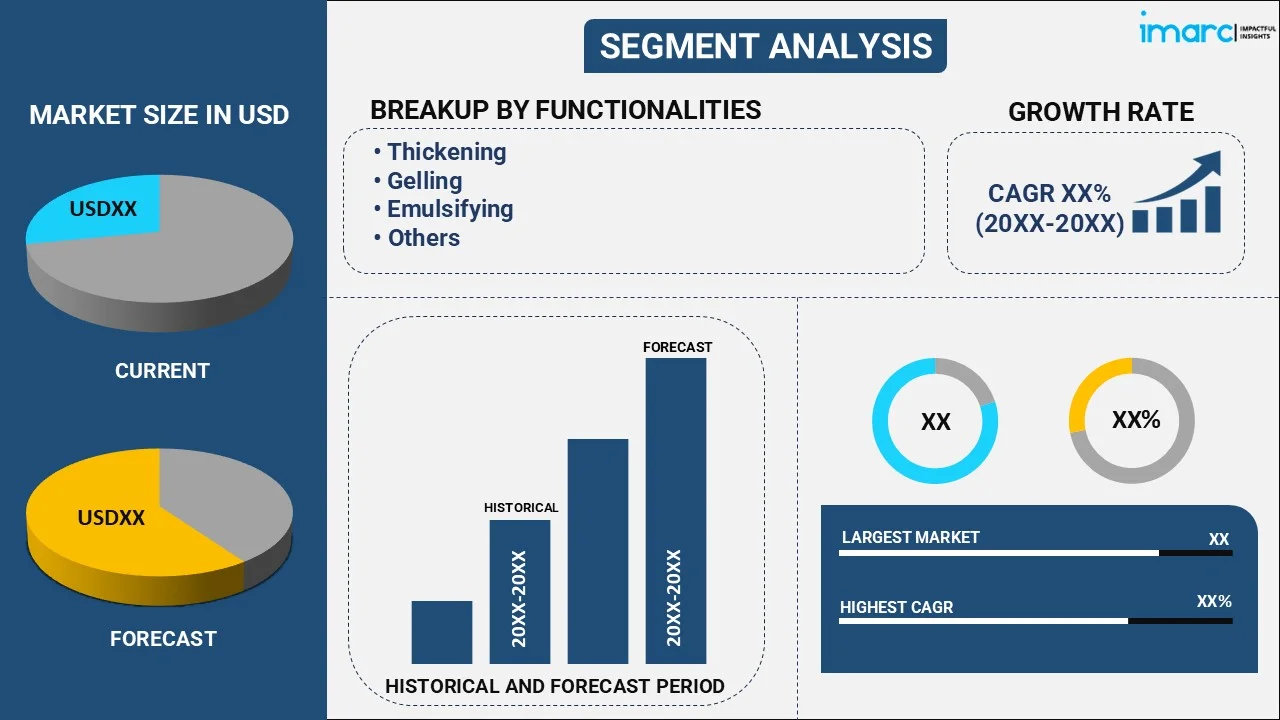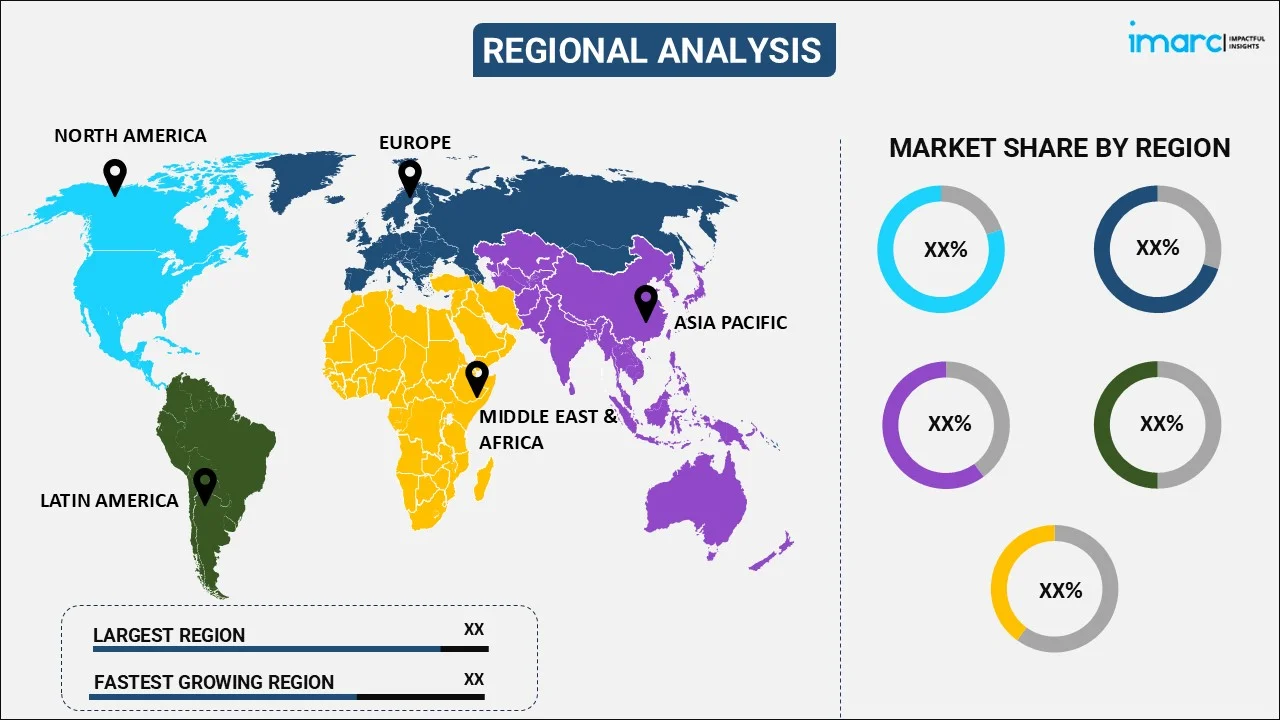
Food Texture Materials Market Report by Functionality (Thickening, Gelling, Emulsifying, Stabilizing, and Others), Application (Bakery, Dairy, Meat & Poultry, Beverages, Snacks, and Others), and Region 2025-2033
Global Food Texture Materials Market:
The global food texture materials market size reached USD 26.7 Billion in 2024. Looking forward, IMARC Group expects the market to reach USD 38.3 Billion by 2033, exhibiting a growth rate (CAGR) of 3.69% during 2025-2033. The rising consumer preference for processed foods with improved texture is promoting the demand for innovative texture solutions, thereby stimulating the market.
|
Report Attribute
|
Key Statistics
|
|---|---|
|
Base Year
|
2024
|
|
Forecast Years
|
2025-2033
|
|
Historical Years
|
2019-2024
|
|
Market Size in 2024
|
USD 26.7 Billion |
|
Market Forecast in 2033
|
USD 38.3 Billion |
| Market Growth Rate 2025-2033 | 3.69% |
Food Texture Materials Market Analysis:
- Major Market Drivers: The growing interest in plant-based and gluten-free products is raising the need for texture-enhancing ingredients in food manufacturing, which is propelling the market.
- Key Market Trends: The rising focus of food companies on improving mouthfeel and consistency in products is facilitating the demand for advanced texture materials, thereby acting as a significant growth-inducing factor.
- Competitive Landscape: Some of the major market companies include Ajinomoto, Archer Daniels Midland Co., Ashland Inc., Avebe, Cargill Inc., CP Kelco, E.I. Dupont DE Nemours & Company, Estelle Chemicals, Fiberstar Inc., FMC Corporation, and Fuerst Day Lawson, among many others.
- Geographical Trends: North America exhibits a clear dominance in the market, driven by demand for processed foods and innovation in plant-based products, as individuals are focusing on improving sensory qualities and consumer experiences.
- Challenges and Opportunities: The struggles with maintaining natural ingredient stability are hindering the food texture materials market's recent opportunities. However, developing advanced stabilizers and emulsifiers that enhance shelf life and texture consistency will continue to strengthen the market over the forecast period.

Food Texture Materials Market Trends:
Rising Demand for Texture Consistency Solutions
Consumers increasingly expect consistent textures in processed and packaged foods, which is driving the need for food texture materials that ensure stability and uniformity. In contrast, these materials help maintain product quality, especially in sauces, dairy, and baked goods, thereby ensuring a pleasing mouthfeel across different batches and extended shelf life. For instance, in August 2024, Roquette introduced four new tapioca-based cook-up starches, namely CLEARAM TR 2010, TR 2510, TR 3010, and TR 4010, which enhance texture, viscosity, and consistency in food applications like sauces, dairy desserts, and bakery fillings. These starches offer improved thickening and heat resistance and are allergen- and gluten-free.
Advancements in Plant-Based Food Technologies
Manufacturers require food texture materials to replicate the mouthfeel of traditional meat and dairy products as plant-based foods grow in popularity. In addition, these innovations focus on creating realistic textures that meet consumer preferences while enhancing the versatility and appeal of plant-based alternatives across a variety of food categories. For instance, in September 2024, Steakholder Foods launched a full-scale Demonstration Center in Israel, highlighting 3D printing technologies for plant-based meat and seafood alternatives. Its features replicate authentic food textures using innovative FPL and DLS methodologies. This is elevating the food texture materials market revenue.
Growing Need for Modified Texture Meals
The food industry sees rising demand for texture-modified meals catering to individuals with specific dietary needs, particularly in healthcare and educational settings. Moreover, food texture materials play a crucial role in delivering safe, palatable meals that meet regulatory standards, such as IDDSI, while maintaining visual and sensory appeal for consumers. For instance, in March 2024, Brakes introduced a range of texture-modified meals, meeting IDDSI level four requirements, for care, hospital, and school caterers. The range includes five meat-based and five vegetarian options, which aids in providing easy-to-serve and great-tasting solutions for those needing modified food textures.
Global Food Texture Materials Industry Segmentation:
IMARC Group provides an analysis of the key trends in each segment of the market, along with the food texture materials market forecast at the global, regional, country levels for 2025-2033. Our report has categorized the market based on functionality and application.
Breakup by Functionality:

- Thickening
- Gelling
- Emulsifying
- Stabilizing
- Others
Emulsifying currently holds the largest food texture materials market share
The report has provided a detailed breakup and analysis of the market based on the functionality. This includes thickening, gelling, emulsifying, stabilizing, and others. According to the report, emulsifying represented the largest market segmentation.
Emulsifying exhibits a clear dominance in the market due to its ability to stabilize mixtures of oil and water, thereby enhancing consistency and mouthfeel. For example, Tate & Lyle recently launched emulsifiers that improve the texture of plant-based beverages.
Breakup by Application:
- Bakery
- Dairy
- Meat & Poultry
- Beverages
- Snacks
- Others
Dairy currently hold the largest food texture materials market demand
The report has provided a detailed breakup and analysis of the market based on the application. This includes bakery, dairy, meat & poultry, beverages, snacks, and others. According to the report, dairy represented the largest market segmentation.
Dairy leads the market due to its versatile applications in enhancing product consistency, creaminess, and mouthfeel. For example, Arla Foods launched a new dairy ingredient designed to enhance the creaminess of low-fat yogurts, thereby reinforcing dairy's leadership in food texture innovations. This is elevating the food texture materials market recent price.
Breakup by Region:

- North America
- United States
- Canada
- Asia Pacific
- China
- Japan
- India
- South Korea
- Australia
- Indonesia
- Others
- Europe
- Germany
- France
- United Kingdom
- Italy
- Spain
- Russia
- Others
- Latin America
- Brazil
- Mexico
- Others
- Middle East and Africa
North America currently dominates the food texture materials market statistics
The food texture materials market outlook has also provided a comprehensive analysis of all the major regional markets, which include North America (the United States and Canada); Asia Pacific (China, Japan, India, South Korea, Australia, Indonesia, and others); Europe (Germany, France, the United Kingdom, Italy, Spain, Russia, and others); Latin America (Brazil, Mexico, and others); and the Middle East and Africa. According to the report, North America accounted for the largest market share.
As per the food texture materials market overview, North America dominates the market due to its well-established food processing industry and rising consumer demand for premium food products with enhanced texture and mouthfeel. Moreover, companies in the region are focusing on innovation to meet these demands. For example, Ingredion launched a new line of texture solutions targeting plant-based and clean-label food products. Furthermore, the region’s strong research and development capabilities, coupled with consumer preferences for quality and innovative food textures, further strengthen its market leadership.
Competitive Landscape:
The market research report has provided a comprehensive analysis of the competitive landscape. Detailed profiles of all major food texture materials market companies have also been provided. Some of the key players in the market include:
- Ajinomoto
- Archer Daniels Midland Co.
- Ashland Inc.
- Avebe
- Cargill Inc.
- CP Kelco
- E.I. Dupont DE Nemours & Company
- Estelle Chemicals
- Fiberstar Inc.
- FMC Corporation
- Fuerst Day Lawson
(Please note that this is only a partial list of the key players, and the complete list is provided in the report.)
Food Texture Materials Market Recent Developments:
- September 2024: Steakholder Foods launched a full-scale Demonstration Center in Israel, highlighting 3D printing technologies for plant-based meat and seafood alternatives. Its features replicate authentic food textures using innovative FPL and DLS methodologies.
- August 2024: Roquette introduced four new tapioca-based cook-up starches, namely CLEARAM TR 2010, TR 2510, TR 3010, and TR 4010, which enhance texture, viscosity, and consistency in food applications like sauces, dairy desserts, and bakery fillings. These starches offer improved thickening and heat resistance and are allergen- and gluten-free.
- March 2024: Brakes introduced a range of texture-modified meals, meeting IDDSI level four requirements, for hospital and school caterers. The range includes five meat-based and five vegetarian options, which aids in providing easy-to-serve and great-tasting solutions for those needing modified food textures.
Food Texture Materials Market Report Scope:
| Report Features | Details |
|---|---|
| Base Year of the Analysis | 2024 |
| Historical Period | 2019-2024 |
| Forecast Period | 2025-2033 |
| Units | Billion USD |
|
Scope of the Report |
Exploration of Historical Trends and Market Outlook, Industry Catalysts and Challenges, Segment-Wise Historical and Predictive Market Assessment:
|
| Functionalities Covered | Thickening, Gelling, Emulsifying, Stabilizing, Others |
| Applications Covered | Bakery, Dairy, Meat & Poultry, Beverages, Snacks, Others |
| Regions Covered | Asia Pacific, Europe, North America, Latin America, Middle East and Africa |
| Countries Covered | United States, Canada, Germany, France, United Kingdom, Italy, Spain, Russia, China, Japan, India, South Korea, Australia, Indonesia, Brazil, Mexico |
| Companies Covered | Ajinomoto, Archer Daniels Midland Co., Ashland Inc., Avebe, Cargill Inc., CP Kelco, E.I. Dupont DE Nemours & Company, Estelle Chemicals, Fiberstar Inc., FMC Corporation, Fuerst Day Lawson, etc. |
| Customization Scope | 10% Free Customization |
| Post-Sale Analyst Support | 10-12 Weeks |
| Delivery Format | PDF and Excel through Email (We can also provide the editable version of the report in PPT/Word format on special request) |
Key Benefits for Stakeholders:
- IMARC's industry report offers a comprehensive quantitative analysis of various market segments, historical and current market trends, market forecasts, and dynamics of the food texture materials market from 2019-2033.
- The research report provides the latest information on the market drivers, challenges, and opportunities in the global food texture materials market.
- The study maps the leading, as well as the fastest-growing, regional markets. It further enables stakeholders to identify the key country-level markets within each region.
- Porter's five forces analysis assists stakeholders in assessing the impact of new entrants, competitive rivalry, supplier power, buyer power, and the threat of substitution. It helps stakeholders to analyze the level of competition within the food texture materials industry and its attractiveness.
- The competitive landscape allows stakeholders to understand their competitive environment and provides insight into the current positions of key players in the market.
Key Questions Answered in This Report
The global food texture materials market was valued at USD 26.7 Billion in 2024.
We expect the global food texture materials market to exhibit a CAGR of 3.69% during 2025-2033.
The sudden outbreak of the COVID-19 pandemic had led to the implementation of stringent lockdown regulations across several nations, resulting in the temporary halt in numerous quality checks of various food products sensed through the fingers, tongue, palate, and teeth, thereby negatively impacting the global market for food texture materials.
The rising demand for food texture materials for conducting texture analysis tests to analyze the mechanical and physical properties of the raw ingredients, food structure, and designs is primarily driving the global food texture materials market.
Based on the functionality, the global food texture materials market has been segregated into thickening, gelling, emulsifying, stabilizing, and others. Among these, emulsifying currently holds the largest market share.
Based on the application, the global food texture materials market can be bifurcated into bakery, dairy, meat & poultry, beverages, snacks, and others. Currently, dairy exhibits a clear dominance in the market.
On a regional level, the market has been classified into North America, Asia Pacific, Europe, Latin America, and Middle East and Africa, where North America currently dominates the global market.
Some of the major players in the global food texture materials market include Ajinomoto, Archer Daniels Midland Co., Ashland Inc., Avebe, Cargill Inc., CP Kelco, E.I. Dupont DE Nemours & Company, Estelle Chemicals, Fiberstar Inc., FMC Corporation, Fuerst Day Lawson, etc.
Need more help?
- Speak to our experienced analysts for insights on the current market scenarios.
- Include additional segments and countries to customize the report as per your requirement.
- Gain an unparalleled competitive advantage in your domain by understanding how to utilize the report and positively impacting your operations and revenue.
- For further assistance, please connect with our analysts.
 Request Customization
Request Customization
 Speak to an Analyst
Speak to an Analyst
 Request Brochure
Request Brochure
 Inquire Before Buying
Inquire Before Buying




.webp)




.webp)












